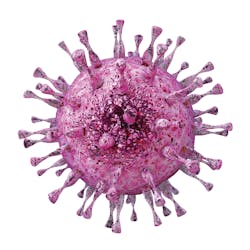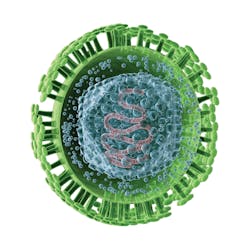The rise of molecular diagnostics for common maternal and fetal tests
For a printable version of the April CE Story and test go HERE or to take test online go HERE. For more information, visit the Continuing Education tab.
LEARNING OBJECTIVES
Upon completion of this article, the reader will be able to:
1. List common pathogens that are passed from mother to infant.
2. Discuss limitations of culture-based pathogen screening methods.
3. Discuss the benefits of molecular-based pathogen screening methods.
4. Describe the etiology, pathogenicity, and past and current screening methods for mother-to-infant pathogenic infections.
In the broad medical domain known as women’s health, one of the highest-impact areas involves caring for women during pregnancy. After all, any testing or treatment performed in this window affects not only the health of the expectant mother but also the health of the baby.
Obstetricians and their clinical laboratory partners are increasingly focused on the identification of viral and bacterial pathogens commonly passed on to the developing fetus during gestation or to the infant during birth. Common infectious disease targets include the herpes simplex virus — both HSV1 and HSV2 — and group B Streptococcus (GBS). A congenital infection of particular concern, cytomegalovirus (CMV), is a well-known healthcare issue, however screening for primary CMV infection or reactivation during pregnancy or for CMV in newborns is currently not included in universal screening recommendations.
All three pathogens are pervasive among the general public and can infect their hosts without triggering symptoms, often for years. As a result, many people are unaware that they are silently harboring these pathogens, leading to increased transmission, possibly to vulnerable pregnant women. While these pathogens can be relatively harmless for healthy adults, infection in utero or during birth can be much more dangerous for a baby’s health and development. This is why testing expecting mothers is essential for delivering effective healthcare for women.
In recent years, technological improvements have made molecular diagnostics an attractive alternative to traditional testing techniques for this particular area of women’s health needs. Molecular detection of HSV1, HSV2, and GBS have produced reliable results with high sensitivity and faster turnaround times, often delivering information in just a few hours, compared to the days or even weeks it can take with culture-based methods.
Now, the advent of sample-to-answer molecular diagnostic systems — instruments that handle everything from sample preparation and pre-analytics to analysis and reporting results with minimal intervention from clinical lab members — offer a new approach to molecular diagnostics for this type of maternal/fetal or mother/newborn testing. These streamlined systems make it easier for even small clinical laboratories to expand their test menus and introduce women’s health testing in a feasible and cost-effective manner.
Why molecular diagnostics matter
For as long as any current practitioner can remember, culture-based testing has been considered the gold standard for diagnosing most infectious diseases. It’s inexpensive, does not require advanced training, and has the advantage of being familiar to pathologists and laboratorians worldwide. After all, direct observation of an organism provides a definitive result.
So why look for alternatives to a testing methodology that has served us well for more than a century? Culture’s one great weakness: time. While culture-based tests generally give reliable results, they do so at their own pace, which is not necessarily in-line with the pace of healthcare. Typical cultures might generate results in 48 hours; with certain slow-growing pathogens, results may take weeks. When additional cultures need to be added, such as for antibiotic susceptibility testing, answers often cannot be produced quickly enough to make a difference in the treatment of a patient.
Fortunately, speed is where molecular diagnostics shine. These tests do not require growing microbes over time; they simply detect and quantify the nucleic acids present in a sample, allowing for diagnosis of known — and sometimes even novel — pathogens based on their DNA or RNA signatures. Depending on the test, results may be generated in an hour or just a few hours. Typically, molecular diagnostics can achieve excellent sensitivity and specificity because of their genomic foundation.
Across many clinical testing indications, molecular diagnostics (often called NAATs for nucleic acid amplification tests) are now included in diagnostic guidelines alongside stalwart methods like culture. In some cases, particularly viral detection, molecular diagnostics have actually supplanted culture to become the recommended laboratory method to aid in diagnosis.
Another reason for the increasing use of molecular diagnostics is their flexibility for expansion. The conserved DNA or RNA genomic targets or signatures of multiple pathogens can be combined in a panel test, allowing laboratorians to test for several of the most common culprits in a single assay. This streamlined approach is instrumental when symptoms of infection overlap, such as testing respiratory infections or gastrointestinal infections. The panel-based approach delivers answers for all pathogens together quickly, while serial testing for each pathogen could drag on for days.
Below, we will review molecular diagnostics in the context of testing for HSV1 & 2, GBS, and CMV.
HSV testing
Both types of HSV lead to lifelong infections, but in many cases, people are asymptomatic and never realize they have the virus. Those who develop symptoms may experience episodic mucocutaneous or cutaneous lesions, or even fulminant encephalitis. In developing babies, exposure to either type of HSV could lead to a dangerous central nervous system infection; left untreated, the infection can be fatal. HSV can be passed by the mother to the infant during birth, or less commonly, in utero or after birth.2-4
For these reasons, it is essential to understand the risk of a mother passing either type of HSV to her baby, particularly if the mother experiences her primary infection while pregnant or has an active outbreak at the time of birth. If a pregnant woman exhibits lesions associated with herpes infection, she should be tested for HSV1 and HSV2. In some cases, it can be challenging for clinicians to distinguish between herpes lesions and lesions from other infections, such as syphilis or varicella-zoster virus (VZV) making panel tests that cover some or all of these pathogens in one assay useful for a definitive diagnosis.
The ability to test for several infectious etiologies simultaneously is one reason that molecular diagnostics are a good fit for HSV1 & 2 testing. Another is speed. Culture-based testing for these viruses typically takes a minimum of two to three days, the ability to maintain mammalian cell-culture lines and specialized staff, while commercially available molecular diagnostic tests can generate highly accurate results in just 60 minutes. That kind of turnaround time may not be essential for the mother, but every minute counts for a potentially infected baby.
When doctors know that a mother had evidence of an active HSV infection while giving birth, they can immediately test the newborn. Comprehensive testing may include “surface specimens” which include eye, mouth, nose and anal swabs as well as swabs of any skin lesions if present, whole blood, and a lumbar puncture to check the cerebrospinal fluid for the presence of the virus.5 Rapid molecular diagnostics can provide results for all of those samples in an hour, but it is important to select a platform that can be used with all sample types.
GBS testing
Among newborns, infection by Group B Streptococcus is one of the leading causes of both meningitis and sepsis, making it a serious concern for neonatal care. According to an estimate from the U.S. Centers for Disease Control and Prevention, 25% of pregnant women are asymptomatically colonized with GBS in genital and rectal mucous membrane areas that a baby would be exposed to during vaginal birth.7 Half of the babies born to infected mothers get infected themselves.8 Vertical transmission of GBS to the newborn occurs either shortly before or during delivery and can result in an invasive infection known as early-onset disease (EOD). Infants with EOD will present with fever, lethargy, sepsis, pneumonia, and, more rarely, meningitis within the first 24 to 48 hours of life. In the 1970s, GBS emerged as the primary cause of infection of infants in the first week of life with fatality rates as high as 50%. In 1990, the CDC estimated an incidence of GBS disease of 1.8 cases per 1,000 live births, but as a result of universal screening and intrapartum antibiotic treatment, GBS EOD has been reduced to an incidence of 0.23 infants per 1,000 live births as of 2015.9 On average, even with universal screening in place, 1,000 babies in the United States develop EOD each year, with approximately 4 to 6% leading to death. Late-onset disease (LOD) can also occur in the neonate around 3 to 4 weeks of age and typically manifests as bacteremia or meningitis with approximately 1,000 babies in the United States affected per year.7
Current clinical practices are focused on the identification of women who are colonized with GBS and are, therefore, at highest risk of transmission to the newborn infant to target administration of intrapartum antibiotic prophylaxis (IAP).10 Universal GBS screening for pregnant women is recommended between the 36-38-week mark using a vaginal-rectal swab.8 Eighteen to twenty-four (18 to 24) hour broth enrichment of the swab is recommended prior to detection of GBS by either subsequent culture or PCR-based detection because enrichment has been shown to increase the sensitivity of detection.11-12 If the results are positive, the patient can be treated with antibiotics during labor. This approach demonstrably reduces the risk of mother-to-baby transmission, reducing EOD occurrence.13
There are several FDA cleared NAATs available for antepartum or intrapartum detection of GBS organisms from vaginal-rectal swab specimens collected from pregnant women. However, the sensitivity of NAATs may be significantly decreased when used for rapid testing while a mother is in labor because the 18-24 hour enrichment step cannot be included in those situations. Neonatal cases of GBS disease have occurred in babies born to mothers whose screens were negative during pregnancy, which underscores the need for high sensitivity testing.5
In the event an infected mother passes GBS to her baby, time is of the essence. Severe infections in the infant can trigger dangerous symptoms within the first day or two after delivery. Rapid diagnosis of GBS infection in the newborn is essential for positive outcomes.
Conventional testing for GBS is performed with culture using blood agar plates followed by a confirmation test such as Christie, Atkins, and Munch-Peterson (CAMP) factor reaction or latex agglutination, which can be labor-intensive and delay results up to 48 hours.9 While this time-consuming process may be acceptable for testing the expectant mother at 36-38 weeks, it is not suitable for testing a newborn who may quickly spiral into a severe and time-sensitive infection crisis. The presence of GBS DNA in normally sterile body fluids such as CSF provides presumptive evidence of neonatal infection.
More and more, physicians are turning to GBS molecular diagnostics instead of conventional culture both for newborns and mothers. These tests’ high sensitivity and specificity outperform that of culture.12 Multiplex panel PCR assays are available in many clinical laboratories for direct testing of CSF that include GBS and other central nervous system pathogens. And given the severity of the risk to an infected neonate, obstetricians cannot afford to miss a positive case in a pregnant woman. Rapid results from a molecular test can also be a significant benefit if the patient goes into pre-term labor, allowing her healthcare team to manage risk carefully through the use of prophylactic antibiotics during labor.
For pregnant women allergic to penicillin — the antepartum treatment typically prescribed to reduce GBS transmission — culture and subsequent susceptibility testing remain helpful for characterizing the pathogen’s antibiotic resistance profile and selecting the best course of treatment.
CMV testing
Human cytomegalovirus (CMV) infection is common and usually results in a mild, non-specific illness in otherwise healthy individuals followed by asymptomatic latency. It is estimated that 50% of adults are infected by age 40 in the U.S. alone.14 However, congenital CMV can wreak havoc during fetal development, and perinatal CMV can cause severe symptoms in newborns. CMV causes more cases of congenital disease than the 29 most commonly screened metabolic and endocrine disorders combined. About 90% of babies born with congenital CMV infection will appear healthy at birth, but up to 20% of these babies may die due to complications from the infection. Later in life, children with CMV may suffer developmental delays and hearing loss — congenital CMV is the leading cause of non-genetic sensorineural hearing loss and neurodevelopmental abnormalities in infants.
Saliva swabs and urine are the preferred sample types for testing newborns for CMV infection. Testing must be performed before the neonate is 21 days old given, after that timeframe, CMV infections may be acquired via environmental exposure. The possible long-term sequelae associated with congenital infection is much more severe than if the infection is acquired post-birth, so knowing the timing of infection is critical for appropriate support. If saliva is used for the initial testing, confirmatory testing with urine is required since CMV seropositive mothers can shed CMV in their breastmilk, potentially contaminating a neonatal saliva swab after a baby has breastfed. Symptomatic congenital CMV infections can be treated with antiviral medications like ganciclovir and valganciclovir. Treatment can potentially decrease the severity of long-term impacts such as hearing loss and developmental delays, and is most efficacious when administered within the first 30 days post-birth.15,16
While the risk of mother-to-baby transmission would argue for universal CMV screening of pregnant women, historically there have not been tests available with sufficient sensitivity and specificity to make this approach helpful or actionable.17 Most laboratory tests currently available to identify a first-time maternal infection can also be challenging to interpret and cannot predict if the fetus may become infected. Because of this, routine screening for primary CMV infection in pregnant women is not recommended in the United States, even when it is part of TORCH screening. In cases where there is strong reason to believe a mother has been infected with CMV, maternal infection and transmission risk may be assessed through antibody testing.
Molecular diagnostics for CMV is recommended to detect the virus in the developing fetus and newborns. Fetal diagnosis can be made with amniocentesis using CMV PCR after 21 weeks of gestation. The standard laboratory test for diagnosing congenital CMV infection in newborns is PCR using saliva swabs with urine collected and tested for confirmation.15 As molecular diagnostic developers continue to expand the number of infectious diseases their tests cover, new options for CMV testing are emerging. As these tests are evaluated and validated through clinical studies, molecular CMV assays to diagnose congenital CMV infection will likely be more broadly available.
Sample-to-Answer systems
For most molecular tests mentioned above, there are many combinations of reagents, kits, and analysis platforms to produce the desired information. Many clinical labs choose to design and validate their own laboratory-developed tests (LDTs) to suit their testing needs. These can be designed on the lab’s platform of choice, making it possible to introduce new tests without investing in new instrumentation.
However, LDTs are not the right choice for all labs. Smaller laboratories that lack deep experience in assay development or where extensive molecular workflows are not common, may prefer to use an FDA-cleared kit.
A recent trend among molecular diagnostic developers has been in response to lab professionals seeking easier-to-use systems that require less hands-on time. These instruments are often known as “sample to answer” or “sample in, answer out.” As the name suggests, sample-to-answer systems handle all the processing steps internally, from sample preparation to thermal cycling and analysis.
Currently available sample-to-answer systems offer low to medium throughput, making them a good option for lower-volume testing needs. They are typically not a viable alternative for testing workflows where labs need to run hundreds or even thousands of samples at a time.
For tests where such high-volume capacity is not required, sample-to-answer systems can allow labs to expand their test offerings quickly without investing in new equipment or validating a new process each time. Some systems are designed to perform all of the benchtop steps for molecular diagnostics within a sample-to-answer workflow. Some of these systems are designed to work with cartridges that perform both the extraction and amplification steps, and other systems eliminate the extraction process altogether through direct testing. There are several sample-to-answer systems available today that offer different cartridges or kits for HSV1/2 and GBS testing as well as for congenital CMV. Because these tests are developed by diagnostic manufacturers and are FDA-cleared as in vitro diagnostics, they do not require the extensive internal development and validation needed for LDTs.
Conclusion
In the arena of women’s health focused on pregnant women and their developing babies, molecular diagnostics offer significant advantages compared to the previous gold standard of culture-based testing. Molecular assays allow clinical laboratory teams to generate answers faster, test more comprehensively, and expand their test menus to meet the needs of their patient population. For HSV1 & 2, GBS, and CMV testing, molecular diagnostics are attractive alternatives to other more laborious and time-consuming assay techniques.
References
- World Health Organization. Herpes simplex virus (10 March 2022). Retrieved March 17, 2022, from https://www.who.int/news-room/fact-sheets/detail/herpes-simplex-virus.
- Brown ZA, Wald A, Morrow RA, et al. Effect of serologic status and cesarean delivery on transmission rates of herpes simplex virus from mother to infant. JAMA. 2003 Jan 8;289(2):203-9. doi: 10.1001/jama.289.2.203. PMID: 12517231.
- Kimberlin DW. Herpes simplex virus infections of the newborn. Semin Perinatol. 2007 Feb;31(1):19-25. doi: 10.1053/j.semperi.2007.01.003. PMID: 17317423.
- James SH, Sheffield JS, Kimberlin DW. Mother-to-Child Transmission of Herpes Simplex Virus. J Pediatric Infect Dis Soc. 2014;3 Suppl 1(Suppl 1):S19-S23. doi:10.1093/jpids/piu050.
- American Academy of Pediatrics. Herpes Simplex. In: Kimberlin DW, Brady, MT, Jackson MA, Long SS, eds. Red Book: 2018 Report of the Committee on Infectious Diseases. 31st ed. Itasca, IL: American Academy of Pediatrics; 2018:410-11.
- Tam T. Van, Kanokporn Mongkolrattanothai, Melissa Arevalo, et al. (2017) Impact of a Rapid Herpes Simplex Virus PCR Assay on Duration of Acyclovir Therapy. J Clin Micro. 55 doi: 10.1128/JCM.02559-16.
- Centers for Disease Control and Prevention. (2018). Group B Strep Fast Facts. Retrieved March 17, 2022, from https://www.cdc.gov/groupbstrep/about/fast-facts.html.
- Prevention of group B streptococcal early-onset disease in newborns. ACOG Committee Opinion No. 797. American College of Obstetricians and Gynecologists. Obstet Gynecol 2020; 5: e51-72. doi: 10.1097/AOG.0000000000003668.
- Filkins L, Hauser J, Robinson-Dunn B, Tibbetts R, Boyanton B, Revell P. Published 10 March 2020. Updated 23 July 2021. Guidelines for the Detection and Identification of Group B Streptococcus. American Society for Microbiology. https://asm.org/Guideline/Guidelines-for-the-Detection-and-Identification-of.
- Puopolo KM, Lynfield R, Cummings JJ; Committee On Fetus And Newborn; Committee On Infectious Diseases. Management of Infants at Risk for Group B Streptococcal Disease. Pediatrics. 2019 Aug;144(2):e20191881. doi: 10.1542/peds.2019-1881. Epub 2019 Jul 8. Erratum in: Pediatrics. 2019 Oct;144(4): PMID: 31285392.
- Philipson EH, Palermino DA, Robinson A. Enhanced antenatal detection of group B Streptococcus colonization. Obstet Gynecol 1995;85:437–9.144 doi: 10.1016/0029-7844(94)00412-7.
- Brianne A. Couturier, Trent Weight, Haley Elmer, et al. (2014) Antepartum Screening for Group B Streptococcus by Three FDA-Cleared Molecular Tests and Effect of Shortened Enrichment Culture on Molecular Detection Rates, J Clin Micro 52, 3429-3432. doi: 10.1128/JCM.01081-14.
- Teatero, S., Ferrieri, P., Martin, I., Demczuk, W., et al. (2017). Serotype Distribution, Population Structure, and Antimicrobial Resistance of Group B Streptococcus Strains Recovered from Colonized Pregnant Women. J. Clin. Microbiol, 55(2), 412-422. doi: 10.1128/JCM.01615-16.
- Jean Beltran PM, Cristea IM. The life cycle and pathogenesis of human cytomegalovirus infection: lessons from proteomics. Expert Rev Proteomics. 2014;11(6):697-711. doi:10.1586/14789450.2014.971116.
- Centers for Disease Control and Prevention. (2020). Babies Born with Congenital Cytomegalovirus (CMV). Retrieved March 17, 2022, from https://www.cdc.gov/cmv/congenital-infection.html.
- Ross SA, Kimberlin D. Clinical outcome and the role of antivirals in congenital cytomegalovirus infection. Antiviral Res. 2021 Jul;191:105083. doi: 10.1016/j.antiviral.2021.105083.
- Akpan US, Pillarisetty LS. Congenital Cytomegalovirus Infection. [Updated 2021 Aug 11]. In: StatPearls [Internet]. Treasure Island (FL): StatPearls Publishing; 2022.
Michelle Tabb, Ph.D., is Chief Scientific Officer at DiaSorin Molecular LLC.
About the Author

Michelle Tabb, PhD
is Chief Scientific Officer at DiaSorin Molecular LLC.


